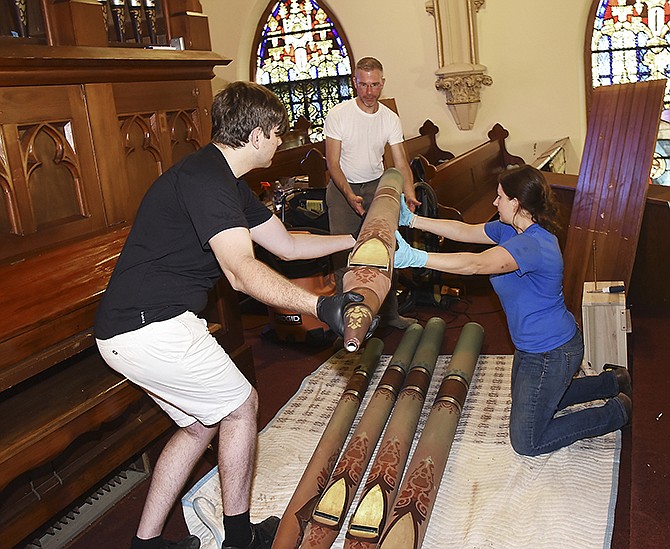The sanctuary at St. Thomas the Apostle Church this weekend will be filled with a long-lost voice - the 1897 Pfeffer pipe organ.
The 490 pipes were re-installed this week by Quimby Pipe Organs Inc. of Warrensburg. For the last three months, company workers have cleaned and repaired the historic instrument piece by piece.
St. Thomas' organ, which originally arrived by steamboat from the St. Louis maker's workshop, is neither the largest nor the most complicated work Quimby has done, said technician Chris Emerson. The firm specializes in organ restoration and rebuilding.
However, the technicians said they enjoyed this project because they were challenged to maintain the authentic integrity of Johann Georg Pfeffer's vision.
"We haven't done anything to it that changes it," Emerson said. "We kept it as original as possible."
For example, some projects want to expand or improve the instrument.
"It's a different approach on restoring versus rebuilding," Emerson said. "We literally could not think outside the box."
This organ has been returned to be played by pump, something common for early churches in rural areas. The pump organ pieces had been stored in the church.
Although the Rev. Jeremy Secrist didn't recognize the pieces stored in the belltower when he first arrived, he was grateful they were there to be restored to the instrument, which had been converted to an electric blower.
That will help in the application to be recognized by the Organ Historical Society with its Historic Pipe Organ Award.
For now, the restored organ is one of only three remaining Pfeffer organs, of more than 600 made, still playable in Mid-Missouri.
Quimby technician Samantha Hancock and her husband, Daniel, will accompany the 5 p.m. Saturday and 10 a.m. Sunday Masses on the Pfeffer, highlighting every function.
"We'll play partially for our own enjoyment," she acknowledged. "What we really want is to give people a broad idea of what the instrument can do in the context of Mass."
A dedication will be held Oct. 2.
Although she is an accomplished organist, she recently earned a master's degree in organ technology. Hancock said she enjoys restoring the instruments more than playing them.
"With something like this, you reach a point where you can say 'I'm finished,'" she said. "That never happens when I'm playing."
To do that, she spent time restoring each stop knob and pipe. The hand-worked methods are the same, though today's pipe organ technicians are aided by more efficient tools, Emerson said.
The pipes vary in material from zinc to wood to a blend of tin and lead, depending on what sound that rank is meant to imitate.
"They each bring different sounds and timbres, like wood is wonderful for flutes," technician Brian Seever said.
"The little, 6-inch wooden pipes are cute," Secrist said.
The two-fold goal of restoring this historic instrument meant it had to be aesthetically pleasing, as well as having an authentic sound quality, Seever said.
"Some people see with their ears and some hear with their eyes," Emerson joked.
The organ restoration follows the church's preservation of its historic stained glass windows.
Between changing times and tornadoes, the windows and the instrument are the only original pieces that remain of the church.
"This organ has nine lives," Secrist said. "Considering the number of times it could have been removed or electrified, how many times it didn't happen, we had to be faithful to this opportunity to restore it."
A historian at heart, Secrist said he is blessed to bring together his interests in organs and history and his faith to benefit the parish.
"How many weddings, funerals and other sacraments has this instrument sang for?" Secrist said. "I wonder what she'll sound like."
For more information, visit stthomasapostle.net/pfeffer-pipe-organ.html.

